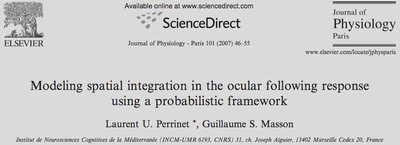Modeling spatial integration in the ocular following response using a probabilistic framework

Abstract
The machinery behind the visual perception of motion and the subsequent sensori-motor transformation, such as in Ocular Following Response (OFR), is confronted to uncertainties which are efficiently resolved in the primate’s visual system. We may understand this response as an ideal observer in a probabilistic framework by using Bayesian theory (Weiss et al., 2002) which we previously proved to be successfully adapted to model the OFR for different levels of noise with full field gratings (Perrinet et al., 2005). More recent experiments of OFR have used disk gratings and bipartite stimuli which are optimized to study the dynamics of center-surround integration. We quantified two main characteristics of the spatial integration of motion : (i) a finite optimal stimulus size for driving OFR, surrounded by an antagonistic modulation and (ii) a direction selective suppressive effect of the surround on the contrast gain control of the central stimuli (Barthélemy et al., 2006). Herein, we extended the ideal observer model to simulate the spatial integration of the different local motion cues within a probabilistic representation. We present analytical results which show that the hypothesis of independence of local measures can describe the integration of the spatial motion signal. Within this framework, we successfully accounted for the contrast gain control mechanisms observed in the behavioral data for center-surround stimuli. However, another inhibitory mechanism had to be added to account for suppressive effects of the surround.
